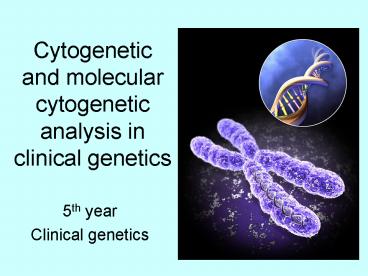Cytogenetic and molecular cytogenetic analysis in clinical genetics - PowerPoint PPT Presentation
1 / 33
Title:
Cytogenetic and molecular cytogenetic analysis in clinical genetics
Description:
Secretary of the Institute of biology and medical genetics ... Gonadal dysgenesis. Infertility. Miscarriages. Delivery of dead fetus or death of a newborn child ... – PowerPoint PPT presentation
Number of Views:1708
Avg rating:3.0/5.0
Title: Cytogenetic and molecular cytogenetic analysis in clinical genetics
1
Cytogenetic and molecular cytogenetic analysis
in clinical genetics
- 5th year
- Clinical genetics
2
Eduard Kocárek
- eduard.kocarek_at_lfmotol.cuni.cz
- Phone (office) 224 435 980
- Secretary of the Institute of biology and medical
genetics - phone 224 433 500 502
3
Basic cytogenetic examinations
- Interphase cells
- Barr body (sex chromatin)
- Metaphase cells staining of chromosomes
- Solid staining
- G-banding
- R-banding
- C-banding
- Q-banding
- Ag-NOR
4
Molecular cytogenetic examinations
- Identification of chromosomal abnormalities by
means of molecular biological methods - Interphase cells could be used for analysis (with
exception of whole chromosome painting probes and
M-FISH) - Examples of methods
- in situ hybridization and its modifications (CGH,
M-FISH, fiber FISH etc.) - Gene chips, resp. array CGH etc.
- PRINS, PCR in situ
- quantitative fluorescent PCR, real time PCR
- methods based on amplification of probe attached
to target sequence (MLPA, MAPH)
5
FISH (fluorescent in situ hybridization)
Locus specific probes
Centromeric probe
target DNA
denaturation
hybridization
probe
M-FISH
Whole chromosome painting probes
6
PRINS
- Primed in situ labeling
Fluorescently labeled nucleotides
7
Quantitative fluorescent PCRQF-PCR
Primer 1
In case of informative polymorphism each peak
represents one locus on one chromosome.
denaturation, annealing
Primer 2
PCR
8
QF-PCR normal finding
9
QF-PCR identification of trisomy
10
MLPA
Multilocus ligase-dependent probe amplification
11
MLPA
12
MLPA computer evaluation
13
MLPA result deletions in the dystrophine gene
14
MAPH
Multilocus amplifiable probe hybridization
DNA attached to the membrane
Mixture of probes
DNA sample
hybridization
Probe 1
Probe 2
Capillary electrophoresis
amplification of attached probes
15
Indications of cytogenetic and molecular
cytogenetic examinations
16
Patient
Basic cytogenetic chromosomal analysis
Molecular cytogenetic analysis (mostly FISH)
Molecular biological analysis
17
Indications for postnatal chromosomal analysis
- Suspicion to concrete chromosomal abnormality
(concrete syndrome) - Multiple congenital anomalies or developmental
delay - Mental retardation
- Gonadal dysgenesis
- Infertility
- Miscarriages
- Delivery of dead fetus or death of a newborn
child - Occurrence of certain malignancies
18
What to do before indication of postnatal
chromosomal analysis?
- Exclude possibility of non-genetic affection
- Influence of teratogens or prenatal infections
- Complications during the birth (asphyxia,
injuries of the newborn child) - Postnatal non genetic influence (injuries,
infections) - Exclude monogenic or multifactorial disorder (
without abnormal chromosomal finding)
19
Tissue samples for postnatal chromosomal analysis
- Peripheral blood
- Fibroblasts from skin biopsy
- Epithelial cells from buccal smear (only in rare
cases for Barr body identification or FISH) - Bone marrow (hemoblastosis)
- Solid tumor
- Autopsy material (in case of the death of a
patient)
20
How to take a blood sample for chromosomal
analysis?
- Disinfect the skin with alcohol (96 ethanol)
- Use tube with heparin or lithium-heparin to
prevent blood clotting. - (The EDTA tube is used only for the DNA
isolation.)
21
In which conditions we have to indicate FISH
analysis?
- The material doesn't contain metaphase
chromosomes - Unsuccessful cultivation
- It isn't possible to cultivate the tissue from
patient (preimplantation analysis, rapid prenatal
examinations, examinations of solid tumors or
autopsy material) - Analysis of complicated chromosomal
rearrangements - Identification of marker chromosomes
- Analysis of low-frequency mosaic
- Diagnosis of submicroscopic (cryptic) chromosomal
rearrangements - Microdeletion syndromes
- Amplification of oncogenes and microdeletion of
tumor-suppressor genes in malignancies
22
Indication
INDICATION
Result
23
Patient
Basic cytogenetic chromosomal analysis
Molecular cytogenetic analysis (mostly FISH)
Molecular biological analysis
24
In which cases we have to indicate detailed
molecular biological analysis?
- Neither chromosomal nor molecular cytogenetic
analysis led to relevant conclusion - Suspicion to monogenic disorder (e.g. fragile X
syndrome) - Some cases of microdeletion syndromes could be
associated with very short deletions or spot
mutations that can't be identified by means of
common molecular cytogenetic methods. - Identification of uniparental disomy, or other
imprinting defects (especially in
Prader-Willi/Angelman syndromes).
25
Patient 1
26
Patient 1
- 2-years old boy with mental retardation
- Inborn cardiac defect supravalvular aortic
stenosis.
See the photo of the patient and note abnormal
phenotypic features.
27
Patient 1 (boy, 2 years)
irides stellatae
hypertelorism
low set ears
abnormal teeth
open mouth, thick lip
elfin face
28
Patient 1
- Phenotypic features and inborn defects are
typical for Williams-Beuren syndrome - This syndrome is caused by microdeletion of the
long arm of the chromosome 7 (sub-band 7q11.23). - In 95 of patients this microdeletion could be
examined by the FISH method. - Before the molecular cytogenetic analysis basic
cytogenetic examination is recommended.
Which type of probe you would use for FISH
analysis of microdeletion of the chromosome 7?
29
Patient 1 - karyotype
Normal finding 46,XY
Microdeletion should be confirmed by the FISH
analysis
30
MOLECULAR CYTOGENETIC ANALYSIS OF 7q11.23
MICRODELETION
- LOCUS SPECIFIC PROBE FOR THE CRITICAL REGION
ELN/LIMK/D7S613 - (labeled with the Spectrum Orange, red signal)
- CONTROL PROBE D7S522
- (labeled with the Spectrum Green, green signal)
31
Patient 1 conclusion of the molecular
cytogenetic examination
- Microdeletion of 7q11.23 chromosome confirmed.
- Diagnosis Williams-Beuren syndrome
32
Prognosis of patients with the Williams-Beuren
syndrome
- Neonatal hypercalcemia
- Mild to moderate mental retardation
- Supravalvular aortic stenosis could lead to a
heart attack already in childhood (sudden death
of the child).
33
Thank you and good bye!































